England has three snake species: venomous adders, grass snakes, and smooth snakes. You might have heard of a slow worm too, but although this looks like a snake, it’s a legless lizard. England’s snake species are not numerous, but there are plenty of them if you look in the right places. This article will discover the most snake-infested areas in England and which species have made the area their home.
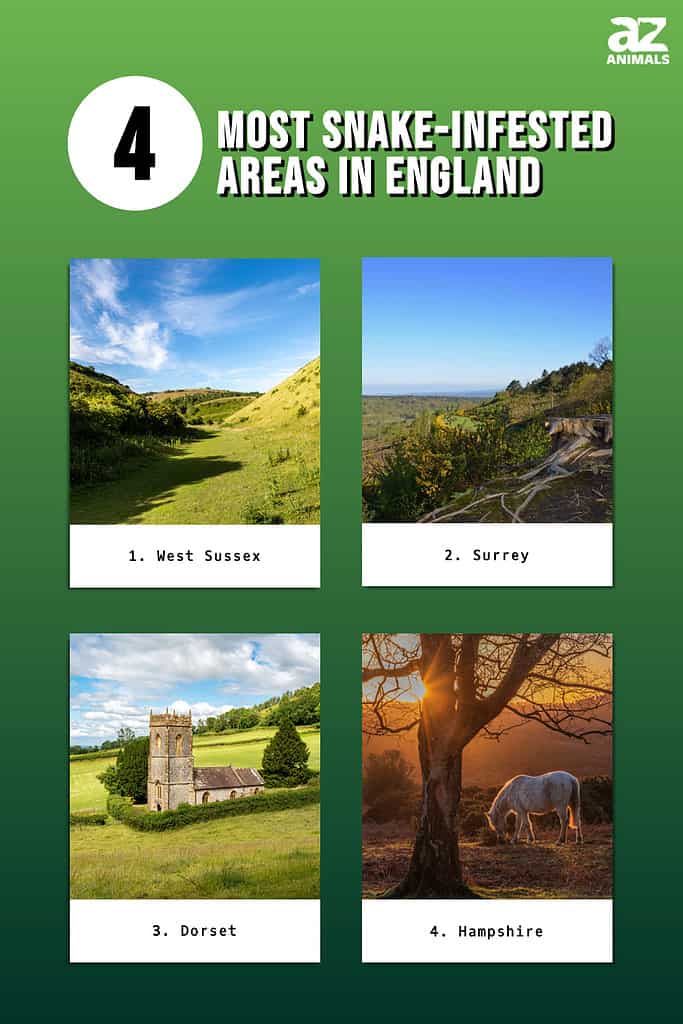
Before we jump into specific areas, let’s look closer at England’s snake species because their needs indicate why they need to live in a certain area.

England is home to three snake species: the adder, the grass snake, and the rare smooth snake.
©Ulf Wittrock/Shutterstock.com
1. Adder
England’s only venomous snake is the adder, but since 1876 only 14 recorded human deaths have been pinned on them. The last United Kingdom adder fatality happened in 1975 in Scotland.
All regions of England record adder bites each year. Bites occur from approximately April to October when adders wake up and look for a warm place to sunbathe. The peak season for adder bites in England is July to August.
Between 50-100 adder bites occur each year in the United Kingdom, and studies show that arms and hands are the most likely bite spots due to people picking up snakes, but accidental bites to a foot or leg occur too.
Nearly every adder bite happens in the countryside’s long grass, but a few bites occur in gardens or during wild swimming forays. Alongside the 50-100 human bites, dogs receive approximately 100 adder bites each year, chiefly to their nose area.
Adders reach around 31 inches long and weigh around 3.5 ounces. Males appear gray with a distinctive dark zigzagged back and red eyes with a vertical slit. Females are usually lighter silvery gray or even reddish-gray. On occasion, quiet walkers spot melanistic black adders.
Adders live in all of England’s regions, where they prey on rodents, lizards, and ground-nesting birds such as skylarks.
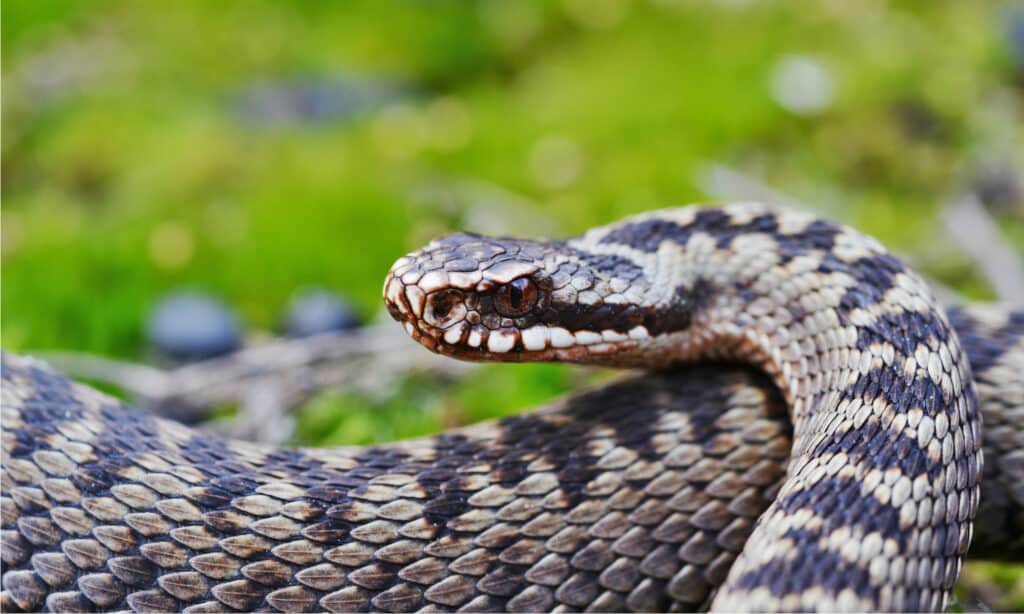
England’s only venomous snake is the adder.
©Holm94/Shutterstock.com
2. Smooth Snake
Smooth snakes only live on a few heathland sites in southern England.
They’re rare constrictors without a venomous bite, even though they partially resemble adders. This rare 30-inch-long reptile strikes as a deterrent, but even if it bit a human or dog, it wouldn’t matter.
Smooth snakes don’t have dark zigzags, and their rounded pupils differ from an adder’s vertical slit, but they hunt down the same kind of prey. Ground-nesting birds, rodents, and lizards are their chief dinner targets.
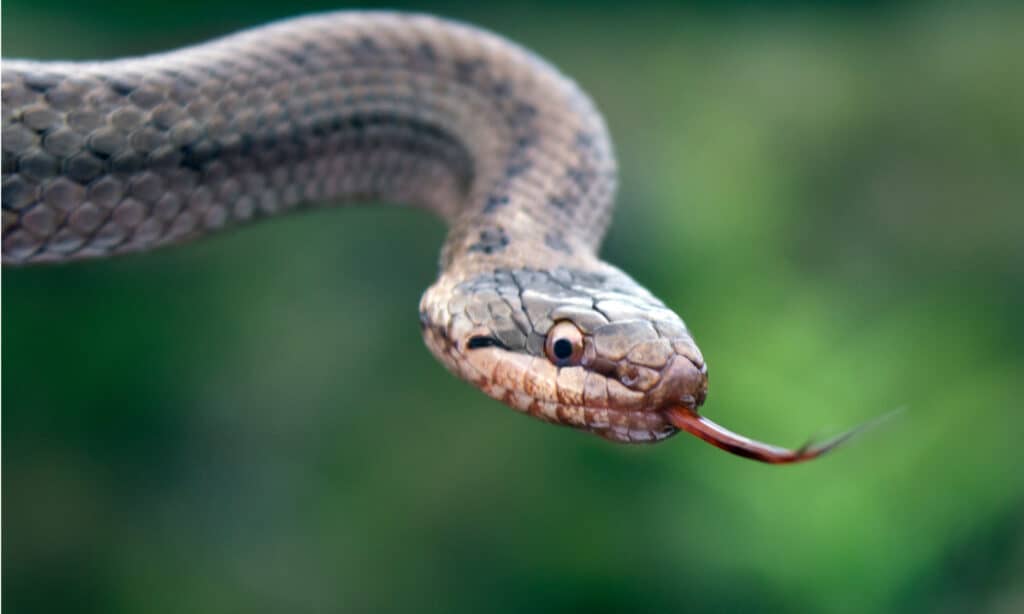
England’s rarest snake is the smooth snake. It’s a constrictor without venom.
©iStock.com/Tom Haley
3. Grass Snake
Harmless to humans and pets, the English grass snake hangs out near water sources, and it’s a superb swimmer. Its chief prey is amphibians, including tadpoles and fish, if they can catch them. Grass snakes reach some epic lengths, up to five feet! Despite this, they’re not dangerous at all and will play dead if threatened.
Green with a yellow and black collar, these secretive snakes usually have pale bellies with dark markings running down their length.
In England, grass snakes prefer to spend time in wetlands, heathlands if water runs nearby, garden ponds in rural areas, and woodlands across the country. More live in the warm southern regions, but England’s north is home to grass snakes too.
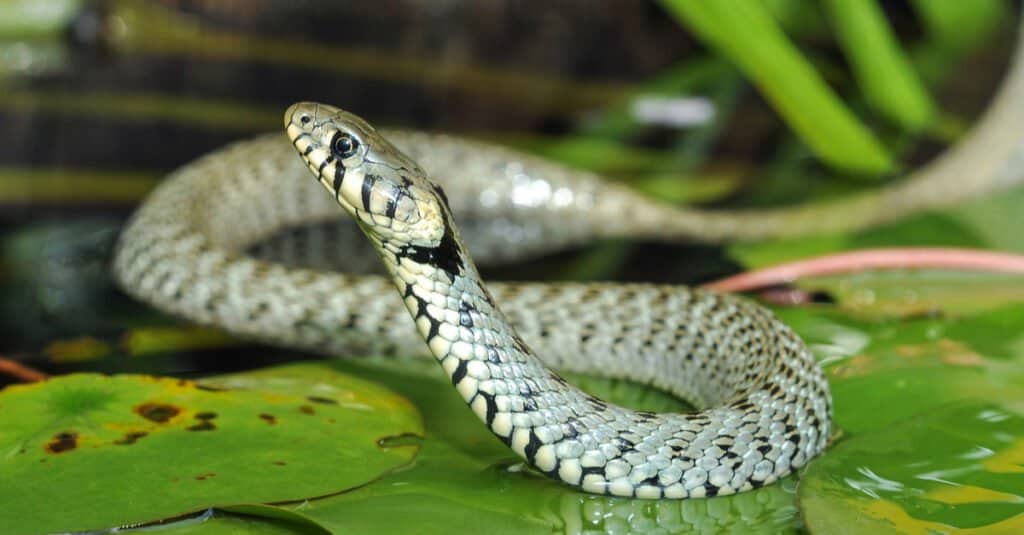
England’s grass snakes prey on amphibians and fish.
©Dr.Pixel/Shutterstock.com
The 4 Most Snake-Infested Areas
That’s a brief rundown of England’s snakes, so let’s move on to the question at hand. Where are England’s most snake-infested areas?
Snakes need warmth to live (they’re cold-blooded reptiles), so it’s no surprise that the majority live on England’s warmer south coast.
1. West Sussex
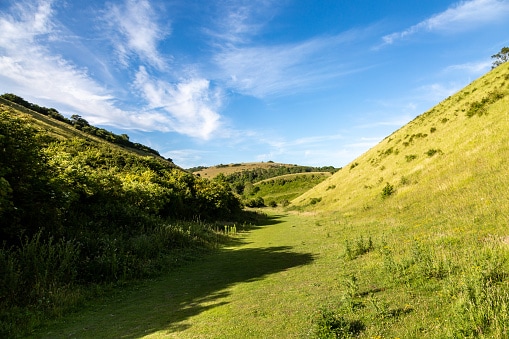
All three of England’s snake species can be found in West Sussex.
©Lemanieh/iStock via Getty Images
West Sussex lies on England’s south coast and shares a border with Surrey, East Sussex, Hampshire, and the English Channel. Its county town is Chichester, and approximately 858,000 people live in its 769 square miles. West Sussex is England’s sunniest county, and snakes inhabit its warm South Downs.
South Downs
Follow the South Down’s Serpent Trail; if you’re quiet, you might spot all three of England’s snake species.
Adders, grass snakes, and the rare smooth snake all live here. Adders prefer forests, grass snakes slither through its wetlands, and smooth snakes enjoy the South Down’s heather and gorse heathlands. The South Downs has a small smooth snake population, so it’s not exactly infested, but it’s rare for this snake to appear anywhere in England. It’s only established in Dorset, Hampshire, Surrey, and West Sussex.
Over the past few years, the media has reported a big increase in adder sightings, including a “large adder at a popular walking spot” that sent locals into panic for some time. The unfortunate adder did not bite anyone. It was simply basking in a sunny spot.
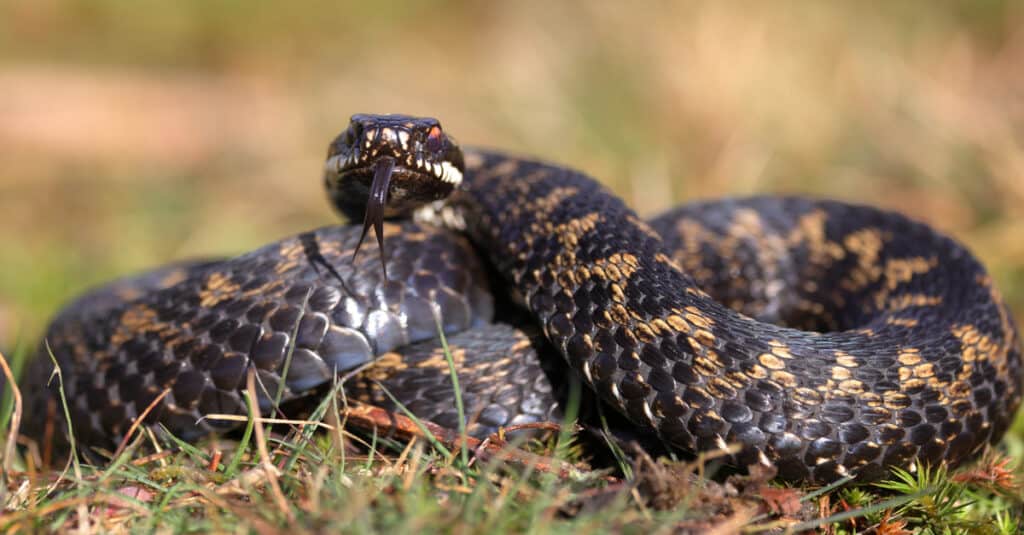
Adders live in the South Downs’ forests and woodland areas.
©Edwin Godinho/Shutterstock.com
2. Surrey
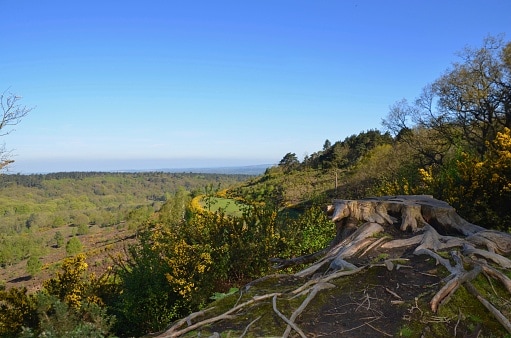
Surry is unofficially called the “bite capital of southeast England.”
©A-Shot-of-Bliss/iStock via Getty Images
Situated in England’s southeast lies Surrey County. Approximately 1.1 million people live in Surrey, and its rich human history dates back to the hunter-gatherer era.
Surrey is known for its proximity to London but is full of heathland, common land, and wide open chalky spaces, making it perfect for reptiles and insects. Surrey is unofficially called the “bite capital of south-east England.” In the past three years, 46 snake bites have been reported here.
Surrey’s Chobham Common is one of the most snake-infested places in England. Although “infested” is a strong word. Even if you’re walking on Chobham Common, spotting a snake is rare.
Chobham Common
This beautiful area is a lowland health managed by Surrey Wildlife Trust. It’s southeast England’s largest national nature reserve shaped by prehistoric agriculture. Over 200 generations are responsible for its current layout.
The Common is an epic wide-open countryside that stretches your eyeballs in all directions. Wildlife abounds here, including birds, deer, rabbits, and reptiles. In particular, the Amphibian and Reptile Conservation Society manages an area south of Sunningdale Golf Course.
The lowland, dry heathland, bell heather, low-growing gorse, and acid boglands here create perfect habitats for all three of England’s snake species. Adders, grass snakes, and smooth snakes, plus the “pretend snake” slow worm and sand lizards, have made it their home.
Smooth snakes were successfully reintroduced here in 2004, and the Reptile Conservation team regularly creates habitats suitable for their lifecycle.
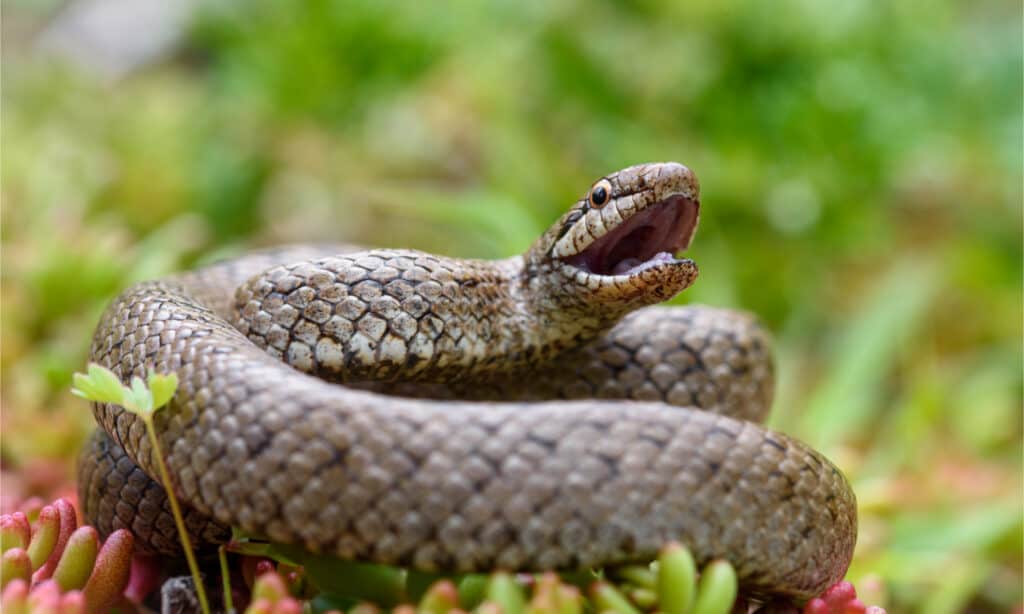
in 2004 smooth snakes were introduced to Chobham Common.
©Pedro Luna/Shutterstock.com
3. Dorset
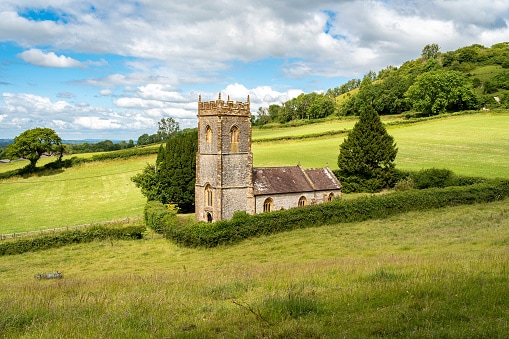
All three of England’s snake species call Dorset home.
©Milos Ruzicka/iStock via Getty Images
The glorious county of Dorset sits on the south coast of England. Its rich farmland and rolling hills sit on chalk, and its coastal lifestyle is popular with students and retired folks. The largest town is the seaside resort of Bournemouth.
Dorset’s residential history stretches back to the Iron Age. Winterbourne Kingston’s prehistoric town of Duropolis, named after the local Iron Age tribe, the Durotriges, recently produced five 6,000-year-old skeletons. Coming right up to date, Dorset’s heathland is one of today’s most snake-infested places. Poole’s Canford Heath, Dorset’s largest heathland, is somewhere snakes love to live.
Canford Heath
Dorset’s heaths provide habitat to all six of England’s native reptiles. That’s three snake species, slow worms, sand lizards, and the common lizard.
Heathland is such a great spot for reptiles because it offers south-facing banks to bask on and plenty of suitable prey. Scrubby heathland on Canford Heath contains England’s rare smooth snake and plenty of adders and grass snakes too.
Unfortunately, Canford Health is prone to wildfire, and according to some estimates, 42 acres burnt to the ground in 2022, killing numerous rare smooth snakes and other reptiles.
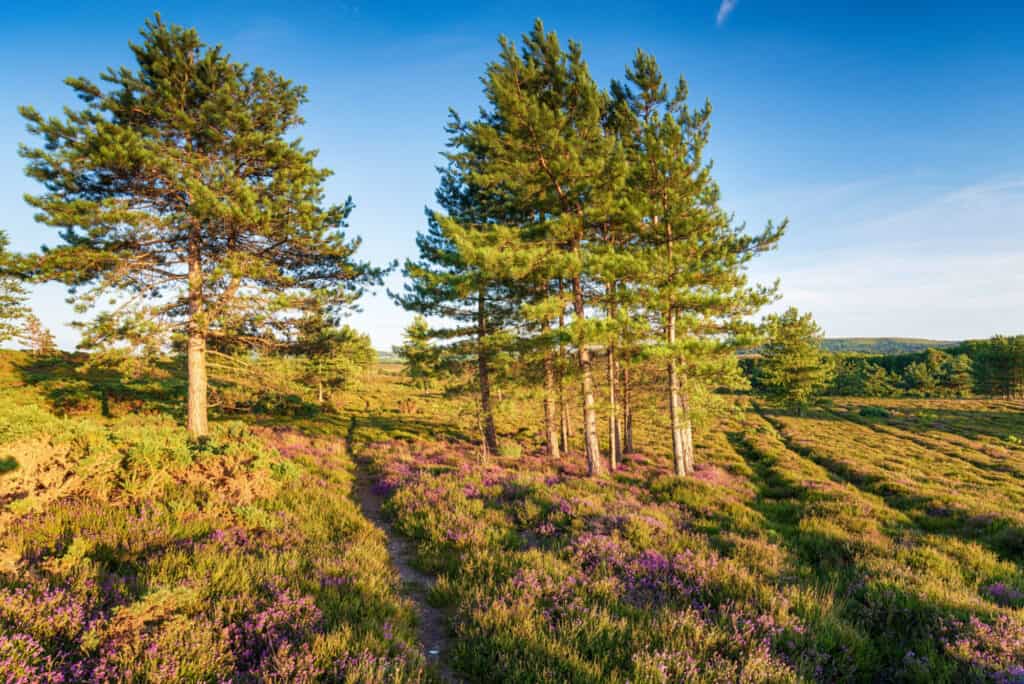
All three of England’s snake species live in Dorset’s heathlands.
©Helen Hotson/Shutterstock.com
4. Hampshire
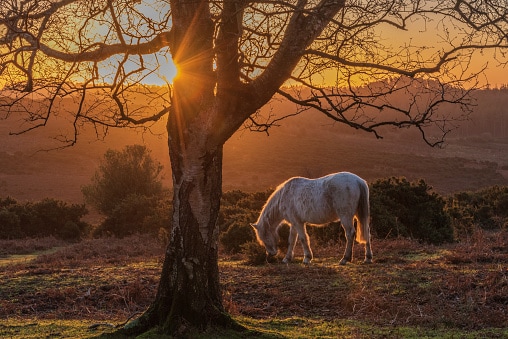
New Forest, Hampshire, was proclaimed a Royal Forest by William the Conqueror in 1086.
©Claire Sheppard/iStock via Getty Images
Bordering Dorset is the county of Hampshire, stretching 47 miles from the coast to Mortimer West End in the north. Its county town is historic Winchester, and a belt of chalk lies northwest creating the Hampshire Downs, a favorite with sun-basking snakes, but according to reptile experts, it’s Hampshire’s New Forest that contains most snakes.
The New Forest
Hampshire’s New Forest is far from new. It’s a historic area that was proclaimed a Royal Forest by William the Conqueror in his 1086 A.D. Domesday book. The New Forest is huge. It’s 220 square miles of unenclosed pasture, forest, and heathlands that’s home to rare English animals like the mole cricket.
In terms of snake-infested areas, all three of England’s snakes reside in the New Forest. Adders inhabit the rough woods, grass snakes enjoy its mires, and rare smooth snakes inhabit gorse and heather heathland.
There’s a pub in the New Forest named “The Snakecatcher” after Brusher Mills, a Victorian man who caught thousands of New Forest adders. Luckily for the snakes, they’re now legally protected.
If you want to see England’s snakes but haven’t had any luck in the wild, try the New Forest Reptile Centre. Set up in 1969, it breeds all three snake species plus rare sand lizards.
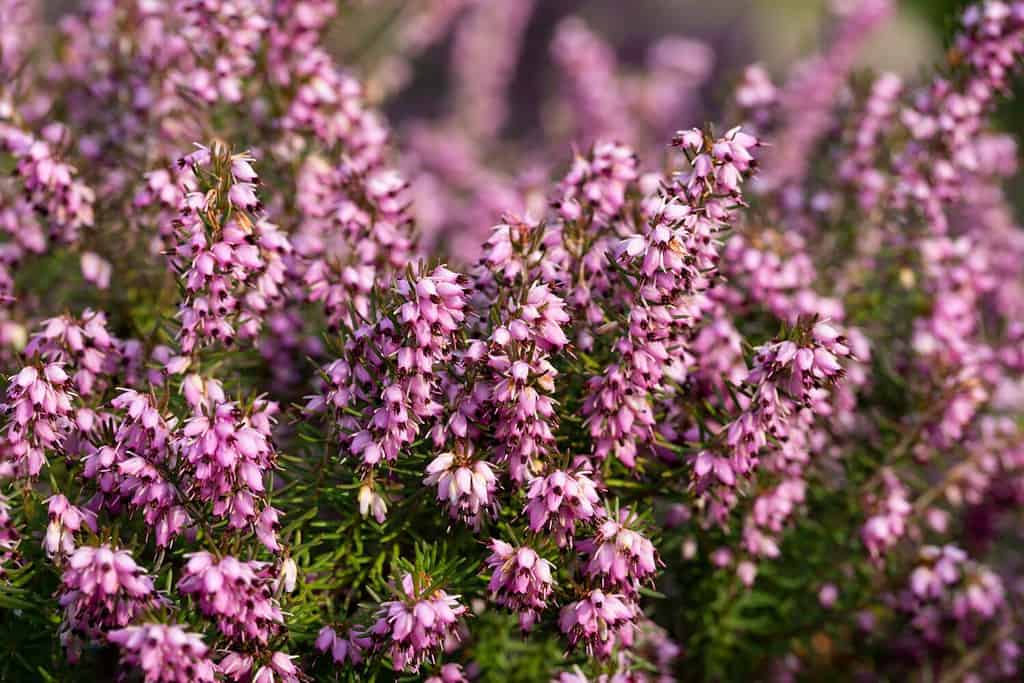
Smooth snakes use heather and gorse to stay hidden in the New Forest.
©AnnaNel/Shutterstock.com
Where to See Snakes in England
So, we’ve seen that England is home to three snake species. Venomous adders and grass snakes spread across the country, but rare and elusive smooth snakes are only found in a few southern counties.
You may be disappointed if you’re looking for snake-infested places in England! England’s snakes are shy, pretty rare overall, and they don’t enjoy human contact.
The best places to spot England’s snakes include West Sussex’s South Downs, Surrey’s Chobham Common, Dorset’s Canford Heath, and Hampshire’s New Forest, but any sunny rough woodland in England may be home to an adder, and grass snakes frequent gardens ponds throughout England too.
Summary of the 4 Most Snake-Infested Areas in England
| Number | Area |
|---|---|
| 1 | West Sussex |
| 2 | Surrey |
| 3 | Dorset |
| 4 | Hampshire |
The photo featured at the top of this post is © Holm94/Shutterstock.com
Discover the "Monster" Snake 5X Bigger than an Anaconda
Every day A-Z Animals sends out some of the most incredible facts in the world from our free newsletter. Want to discover the 10 most beautiful snakes in the world, a "snake island" where you're never more than 3 feet from danger, or a "monster" snake 5X larger than an anaconda? Then sign up right now and you'll start receiving our daily newsletter absolutely free.
Thank you for reading! Have some feedback for us? Contact the AZ Animals editorial team.






